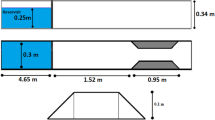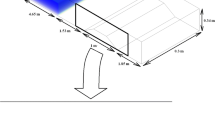Abstract
In this study, a method based on the Navier-Stokes equation was developed to simulate the dam break flow. The free surface movement of water is carried out using the Newtonian fluid model, and the mud impurity movement is performed by the model of non-Newtonian fluid based on the volume of fluid (VOF) method. In order to minimize the fluctuations of the free surface near a moving front, the VOF method was used. The numerical Pressure-Implicit with Splitting of Operators (PISO) algorithm was chosen as a numerical method for solving equations. The developed model is verified with a wide range of measurement results and with the computational data of other authors. Good computational data were obtained from flood forecasting resulting from the instantaneous collapse of the dam. It has been demonstrated that this model is well balanced and reliable, and can accurately record the movement of dam break in difficult terrain. With the help of the proposed model, the Mynzhylky dam break flow was modeled.








Similar content being viewed by others
References
Aizenger V, Dawson C (2002) A discontinuous Galerkin method for two-dimensional flow and transport in shallow water. Adv Water Resour 25(1):67–84
Aliparast M (2009) Two-dimensional finite volume method for dam-break flow simulation. International Journal of Sediment Research 24(1):99–107
Ancey C, Cochard S (2009) The dam-break problem for Herschel-Bulkley viscoplastic fluids down steep flumes, J. Non-Newtonian Fluid Mech 158(1–3):18–35
Barton IE (1998) Comparison of SIMPLE and PISO type algorithms for transient flows. Int J Numer Methods Fluids 26(4):459–483
Bell SW, Elliot RC, Chaudhry MH (2010) Experimental results of two-dimensional dam-break flows. J Hydraul Res 30:225–252
Begnudelli L, Sanders BF (2006) Unstructured grid finite volume algorithm for shallow-water flow and scalar transport with wetting and drying. J Hydraul Eng 132(4):371–384
Bermúdez A, Dervieux A, Desideri JA, Vázquez ME (1998) Upwind schemes for the two-dimensional shallow water equations with variable depth using unstructured meshes. Comput Methods Appl Mech Eng 155(1–2):49–72
Bradford SF, Sanders BF (2002) Finite-volume model for shallow-water flooding of arbitrary topography. J Hydraul Eng 128(3):289–298
Brufau P, García-Navarro P (2000) Two-dimensional dam break flow simulation. Int J Numer Methods Fluids 33(1):35–57
Chambon G, Ghemmour A, Laigle D (2009) Gravity-driven surges of a viscoplastic fluid: an experimental study, J. Non-Newtonian Fluid Mech. 158(1–3):54–62
Coussot P (1995) Structural similarity and transition from Newtonian to non-Newtonian behavior for clay-water suspensions. Phys Rev Lett 74(20):3971–3974
Emelen S, Zech Y, Soares-Frazão S (2015) Impact of sediment transport formulations on breaching modelling. J Hydraulic Res 53(1):60–72
Erduran KS, Kutija V, Hewett CJM (2002) Performance of finite volume solution to the shallow water equations with shock-capturing schemes. Int J Numer Methods Fluids 40:1237–1273
Ern A, Piperno S, Djadel K (2008) A well-balanced Runge-Kutta discontinuous Galerkin method for the shallow-water equations with flooding and drying. Int J Numer Methods Fluids 58(1):1–25
Eskilsson C, Sherwin SJ (2010) A triangular spectral/hp discontinuous Galerkin method for modeling 2D shallow water equations. Int J Numer Methods Fluids 45(6):605–623
Evangelista S, Altinakar MS, Di Cristo C, Leopardi A (2013) Simulation of dam-break waves on movable beds using a multi-stage centered scheme. International Journal of Sediment Research 28(3):269–284
Fraccarollo L, Toro EF (1995) Experimental and numerical assessment of the shallow water model for two-dimensional dam-break type problem. J Hydraul Res 33(6):843–864
Fraccarollo L, Capart H (2002) Riemann wave description of erosional dam-break flows. J Fluid Mech 461:183–228
Goutier L, Soares-Frazão S, Savary C, Laraichi T, Zech Y (2008) One-dimensional model for transient flows involving bed-load sediment transport and changes in flow regimes. J Hydraul Eng 134(6):726–735
Gotoh H., Fredsøe J.(2000) Lagrangian two-phase flow model of the settling behavior of fine sediment dumped into water. In: Proceedings of the ICCE, Sydney, Australia. 3906–19
Hosseinzadeh-Tabrizi A, Ghaeini-Hessaroeyeh M (2018) Modelling of dam failure-induced flows over movable beds considering turbulence effects. Comput Fluids 161:199–210
Hirt CW, Nichols BD (1981) Volume of fluid (VOF) method for the dynamics of free boundaries. J Comput Phys 39:201
Harten A, Lax P, van Leer B (1983) On upstream differencing and Godunov type methods for hyperbolic conservation laws. SIAM rev 25(1):35–61
Hogg AJ, Woods AW (2001) The transition from inertia to drag-dominated motion of turbulent gravity currents. J Fluid Mech 449:201–224
Hogg AJ, Pritchard D (2004) The effects of drag on dam-break and other shallow inertial flows. J Fluid Mech 501:179–212
Issa RI (1986) Solution of the implicitly discretized fluid flow equations by operator splitting. J Comput Phys 62(1):40–65
Issakhov A (2016) Mathematical modeling of the discharged heat water effect on the aquatic environment from thermal power plant under various operational capacities. Appl Math Model 40(2):1082–1096
Issakhov A, Zhandaulet Y, Nogaeva A (2018) Numerical simulation of dam break flow for various forms of the obstacle by VOF method. Int J Multiphase Flow 109:191–206
Issakhov A, Imanberdiyeva M (2019) Numerical simulation of the movement of water surface of dam break flow by VOF methods for various obstacles. Int J Heat Mass Transf 136:1030–1051
Janosi IM, Jan D, Szabo KG, Tel T (2004) Turbulent drag reduction in dam break flows. Exp Fluids 37:219–229
Kleefsman KMT, Fekken G, Veldman AEP, Iwanowski B, Buchner B (2005) A volume-of-fluid based simulation method for wave impact problems. J Comput Phy 206(1):363–393
Lai WC, Khan AA (2012) Modeling dam-break flood over natural rivers using discontinuous Galerkin method. J Hydrodyn 24(4):467–478
Leal J, Ferreira R, Cardoso A (2010a) Geomorphic dam-break flows. Part I: conceptual model. Proceedings of the Institution of Civil Engineers – Water Management 163(6):297–304
Leal J, Ferreira R, Cardoso A (2010b) Geomorphic dam-break flows. Part II: numerical simulation. Proceedings of the Institution of Civil Engineers – Water Management 163(6):305–313
Lin GF, Lai JS, Guo WD (2005) High-resolution TVD schemes in finite volume method for hydraulic shock wave modeling. J Hydraul Res 43(4):376–389
Liska R, Wendroff B (1998) Composite schemes for conservation laws. SIAM J Numer Anal 35(6):2250–2271
Lauber G, Hager WH (1998) Experiments to dam break wave: horizontal channel. J Hydraul res 36(3):291–307
Li J, Cao Z, Pender G, Liu Q (2013) A double layer-averaged model for dam-break flows over mobile bed. J Hydraul Res 51(5):518–534
Li X, Zhao J (2018) Dam-break of mixtures consisting of non-Newtonian liquids and granular particles. Powder Technol 338:493–505
Marsooli R, Wu W (2014) 3-D finite-volume model of dam-break flow over uneven beds based on VOF method. Adv Water Resour 70:104–117
Ozmen-Cagatay H, Kocaman S (2011) Dam-break flow in the presence of obstacle: experiment and CFD simulation. Eng Appl Comput Fluid Mech 5(4):541–552
Papanicolaou AN, Elhakeem M, Krallis G, Prakash S, Edinger J (2008) Sediment transport modeling review - current and future developments. J Hydraul Eng 134(1):1–14
Song L, Zhou J, Li Q (2010) An unstructured finite volume model for dam-break floods with wet/dry fronts over complex topography. Int J Numer Methods Fluids 67(8):960–980
Schwanenberg D, Harms M (2004) Discontinuous Galerkin finite-element method for transcritical two-dimensional shallow water flows. J Hydraul Eng ASCE 130(5):412–421
Soares-Frazão S, Canelas R, Cao ZX, Cea L, Chaudhry HM, Moran AD (2012) Dam-break flows over mobile beds: experiments and benchmark tests for numerical models. J Hydraul Res 50(4):364–375
Swartenbroekx C, Zech Y, Soares-Frazão S (2013) Two-dimensional two-layer shallow water model for dam break flows with significant bed load transport. Int J Numer Methods Fluids 73:477–508
Tsakiris G, Spiliotis M (2013) Dam- breach hydrograph Modelling: an innovative semi- analytical approach. Water Resour Manag 27(6):1751–1762
Tseng MH, Yen CL (2004) Evaluation of some flux-limited high-resolution schemes for dam-break problems with source terms. J Hydraul Res 42(5):507–516
Tu S, Aliabadi S (2005) A slope limiting procedure in discontinuous Galerkin finite element method for gas dynamics applications. Int J Numer Anal Model 2(2):163–178
Toro EF, Spruce M, Speares W (1994) Restoration of the contact surface in the HLL-Riemann solver. Shock Waves 4:25–34
Xing Y, Zhang X, Shu C (2010) Positivity-preserving high order well-balanced discontinuous Galerkin methods for the shallow water equations. Adv Water Resour 33(12):1476–1493
Xia J, Lin B, Falconer R, Wang G (2010) Modelling dam-break flows over mobile beds using a 2D coupled approach. Adv Water Resour 33:171–183
Ying X, Jorgeson J, Wang S (2008) Modeling dam-break flows using finite volume method on unstructured grid. Engineering Applications of Computational Fluid Mechanics 3(2):184–194
Yu H, Huang G (2014) A coupled 1D and 2D hydrodynamic model for free-surface flows. Proceedings of the Institution of Civil Engineers – Water Management 167(9):523–531
Yoon TH, Kang S (2004) Finite volume model for two-dimensional shallow water flows on unstructured grids. J Hydraul Eng ASCE 130(7):678–688
Zhang S, Duan JG (2011) 1D finite volume model of unsteady flow over mobile bed. J Hydrol 405:57–68
Acknowledgements
This work is supported by grant from the Ministry of education and science of the Republic of Kazakhstan. (AP05132770)
Author information
Authors and Affiliations
Corresponding author
Ethics declarations
Conflict of Interests
The author declares that there is no conflict of interests regarding the publication of this paper.
Additional information
Publisher’s Note
Springer Nature remains neutral with regard to jurisdictional claims in published maps and institutional affiliations.
Rights and permissions
About this article
Cite this article
Issakhov, A., Zhandaulet, Y. Numerical Study of Dam Break Waves on Movable Beds for Complex Terrain by Volume of Fluid Method. Water Resour Manage 34, 463–480 (2020). https://doi.org/10.1007/s11269-019-02426-1
Received:
Accepted:
Published:
Issue Date:
DOI: https://doi.org/10.1007/s11269-019-02426-1




